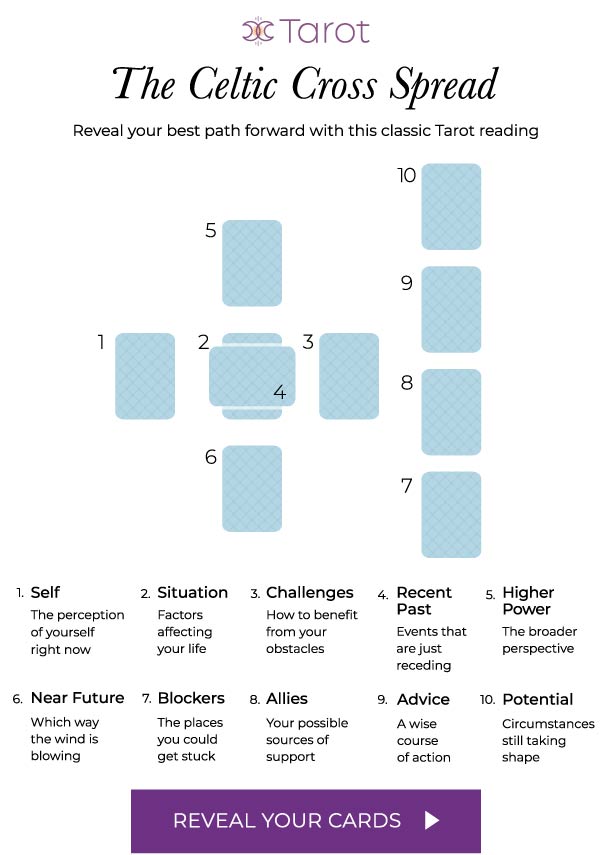
Learn to Read Tarot: Tarot Card Spreads and Tips for Beginners
Follow this guide to get started on your Tarot journey
Have you ever wanted to read Tarot or interpret your own cards … but felt totally overwhelmed about getting started? You’re not alone! Every experienced Tarot reader in the world started with the same curiosity and confusion. Fortunately, the cards are a lot more friendly and easier to understand than you might think.
How Tarot Works: What is a Tarot Reading?
Tarot is a divination system that uses a specific set of 78 illustrated cards. These 78 cards each come with their own specific meanings, built up over hundreds of years by countless Tarot readers and experts.
A Tarot reading focuses on a small selection of Tarot cards, usually pulled from the deck at random, to answer questions and provide guidance. The person reading the cards (or interpreting their meaning) will pay attention to the colors and symbols they see, the way the characters interact, the traditional significance of the cards, and -- most importantly -- their own intuition in order to translate any messages the Tarot is trying to convey.
Using Tarot Cards: How Do I Read Tarot for Myself?
The truth that the Tarot provides can feel unbelievably magical, but here’s the reality: the magic of Tarot really comes from you! It's all in your ability to focus on your Tarot reading with real intention and purpose.
Every Tarot reader has their own unique way of approaching the cards and delivering a reading, and in the "How to Read Tarot Cards for Beginners" section below, we give a step-by-step process to get you started. First, though, it’s important to talk through some underlying principles of reading Tarot. These are essential to working with the cards in a healthy, empowering way.
Read Tarot with your intuition
Tarot is a time-honored system based on 78 archetypal energies, each with its own name and traditional meaning. When you get right down to it, though, a Tarot reading is not a math equation. There’s not a single “right” solution or interpretation you’re striving to identify. Instead, Tarot works with the power of intuition.
Those instinctive feelings about what the cards mean, both on their own and in relation to each other, come from your head, your heart, your gut, your memory, your personal associations, and your connection to the collective unconscious. Add all this together and you’ll find your own unique insight.
Your interpretations might not always “make sense” at first glance, but they don’t have to! Tarot is a profound practice in trusting your intuition. Your ability to do this will only grow as you interact with the cards and learn how to distinguish your inner voice from external influences.
Take your time
As much as possible, try not to rush through a Tarot reading. You’ll be able to discover fascinating insights and explore your own feelings more thoroughly if you have room to sit with the cards and consider them in a low-pressure way.
If you get interrupted during your reading or don’t have much time to begin with, do what you can to keep contemplating the cards as you go about your day. You can take a picture of the reading, journal about it, jot some notes down on your phone, etc. As you reflect on the cards, some thoughts or ideas might pop into your head unexpectedly. These are no coincidence -- pay attention!
Asking the Cards: How to Ask Questions in a Tarot Reading
The key to a truly great Tarot reading is understanding how to phrase your question and making a conscious effort to get real with yourself and your situation.
For starters, it’s best to keep the questions open-ended. Stay away from inquiries that can be answered with a clear “Yes” or “No”, as well as phrases that demand a definite answer. Tarot is a tool for exploring possibilities, not a vending machine for delivering easy solutions.
If your first instinct is to ask a question that’s a little too narrow, think about how you might broaden your search. One trick is to look for the hidden questions inside your obvious dilemma.
Struggling to know whether you should accept a new job opportunity? Instead of asking if you should take the position you’ve been offered (a clear Yes/No question), you could try asking questions like these:
“What can I expect if I take this new role?”
“How can I pursue a career path that will satisfy me?”
“Why did this opportunity come along at this time?”
Worried about a situation with your significant other? Instead of asking if you should end the relationship (a clear Yes/No question) or for the name of the person you’d be better off pursuing (a question with a definite answer), ponder these ideas:
“What can I do to prepare myself for long-lasting love?”
“How can my partner and I reconnect with each other?”
“Why does this situation feel so distressing to me?”
The key here is to think of Tarot not as some all-knowing oracle, but simply as a friend or trusted advisor. If you can come up with a question that starts a conversation, you’ll be much more likely to walk away with a sense of confidence and clarity.
If you’re too stressed, confused, or overwhelmed to come up with a question, try not to worry. Sometimes all you have to do is say, “I don’t know what’s going on! Help me out here!” You’re allowed to get right into the cards and see what you can uncover.
Interpreting the Cards: How Do I Give a Tarot Reading?
The dynamics change slightly when you’re reading Tarot for another person rather than for yourself. For one thing, the experience is more collaborative. You’re bringing your knowledge to the table, but the other person is as well. They have an intimate understanding of whatever they’re going through, making them the expert, but your perspective as an outsider is valuable too. You’re working together on this Tarot reading!
Here are some things to keep in mind if you’re giving a Tarot reading to someone else:
- Prioritize the needs of the other person. This is not about you! Your role in this situation is to be a support and offer your perspective and skill as a Tarot reader. Check your ego at the door.
- Help the other person find their question, if needed. The person sitting across from you might show up with a clear question in mind. If the question needs a little tweaking, make some gentle suggestions. If they’re not sure what they want to ask, just let them talk for a little while. Notice the questions that come up organically, then tailor your reading to those questions.
- Be willing to deliver information without judgment. In Tarot readings, we often examine very personal dilemmas and sources of pain. The fact that the other person is sharing those issues with you indicates a high degree of trust. Do everything you can to honor that trust and share your interpretations of the cards with honesty and kindness.
- Support the other person as they read their own cards. An important rule of thumb: in nine out of ten cases, the other person’s way of interpreting the cards trumps your own. They might see something in The Emperor or the Four of Cups that’s a little unorthodox or that wouldn’t occur to you normally. This is a great thing! Support them as they express their intuitive feelings about the cards. Feel free to volunteer your own ideas, too, but it’s best to bring these up as possibilities, not as interpretations that take precedence.
Let’s take a look at a sample Tarot reading and how you might interpret the cards both for yourself and for another person.
In this example, we’ll look at a two-card spread. Imagine that these are cards you pulled for yourself when trying to decide whether to have a difficult conversation with a friend. The first card, The Magician, represents the option to have the conversation, and the second card, the Three of Cups reversed, represents the option to avoid the conversation.

What does The Magician have to say? This is a card of creativity and spiritual potential. Since it represents the option to have this conversation with your friend, The Magician indicates that talking things through will likely allow for growth, despite any intensity that arises as a result. There might be a new beginning for your friendship on the other side of that chat. According to this card, having the conversation is an important way to step into your own power.
And what about the Three of Cups? This card is reversed, meaning it appeared out of the deck upside down. The Three of Cups speaks to themes of connection and mutual support among loved ones, but the reversal suggests that this energy is somewhat blocked. Remember, in our example, this is the card you pulled to represent the option of avoiding a difficult conversation with your friend. The Three of Cups reversed is a sign that taking this course will diminish your bond with them -- or perhaps that the bond is already waning.
Now, let’s look at the same question and cards again, but this time, we’ll imagine that you’re reading them for another person.

As you’re interpreting the cards, it’s best to ask for the other person’s ideas first.
The Magician still represents the option of having a tough conversation with their friend, but in this case, the person sitting down with you mentions that The Magician looks really intimidating. They see this card as something overbearing and scary, not as a harbinger of creative potential. Honor their intuition! This is an opportunity to let the person talk about why they’re nervous about addressing things with their friend.
The Three of Cups reversed represents the option of avoiding this hard conversation altogether. The person sitting down with you sees the dancing women on the card and remembers fun times dancing and partying with this friend of theirs. They’re not sure what to do with that information, so you bring up the fact that the card is upside down and ask them to think about what has changed since those carefree days together. This line of questioning helps them conclude that avoiding a hard conversation is a way of keeping this friend at a distance.
Again, Tarot readings are not math equations! Neither of these readings are more “correct” than the other. Even with the exact same cards and question, the interpretations are slightly different between these two readings. Nevertheless, both examples allow for deep introspection and offer insights that will lead to a powerful decision.
How to Read Tarot Cards for Beginners
Now that we’ve covered some of the theory, let’s get to the actual steps of a Tarot reading!
- Find a calm environment, inside and/or out. Ideally, you’ll be able to do your Tarot reading in a space where you won’t be interrupted and where you can feel truly relaxed. Of course, this isn’t always possible! You might want to do an online Tarot reading on the train during your commute to work, or you might live with people who barge in unannounced (parenthood, anyone?). In those cases, use breathing exercises, meditation, and mantras to find a place of inner calm, even just for a few minutes.
- Figure out your question and Tarot spread. Ponder the issues you’re navigating at the moment, then use the guidelines above to come up with a question that feels right. Decide what spread you’d like to use (we’ve got some ideas below). The right spread might depend on how much time you have available. If you only have ten minutes, for example, a twelve-card spread probably won’t work. Stick with two or three cards instead.
- Shuffle your cards. There’s no right or wrong way to shuffle! Mix up the cards in whatever way you prefer.
- Cut the deck and draw the correct number of cards. Many Tarot readers like to cut the deck with the left hand, since it’s closer to the heart. Lay out the cards in the spread as you pull them from the pile, turning each one face up as you go.
- Sit with the cards and see what you notice. Pay attention to your first impressions. Does one card stand out from the rest? Are there several cards from one suit? Are any of the people on the cards facing each other or interacting in surprising ways? Beyond first impressions, you can look at each card individually and interpret it, using your intuition and any trusted resources (including guidebooks or our own collection of Tarot card meanings).
- Draw an additional clarifying card if needed. If anything about the reading has you stumped, shuffle again and draw one more card. The card you receive is sort of the bottom line for your entire reading experience, the information that ties everything together.
- Come up with a heart-centered interpretation. Whether you’re reading for another person or for yourself, it’s nice to summarize your insights at the end of the reading. You can write the interpretation down or make a voice recording on your phone. That way, you’ll be able to look back on the reading in future weeks or months and reflect on the meaning with even greater perspective.
- When the reading is complete, return the cards to the deck. Take the cards you’ve been interpreting and place them back in the complete deck. You may want to shuffle another time or two to officially close the reading.
These steps are meant to help you get started on your Tarot reading journey. Feel free to adjust them in any way that feels right for your personality and goals!
Beginner Tarot Spreads
Start with 3-card spreads
Our best advice for Tarot beginners is to start small. Drawing even one card from the deck, maybe as a thoughtful ritual to kick off your day, is a great idea! If you’re ready to sit down and do a complete reading, we suggest pulling three cards. This number seems to deliver a lot of thought-provoking information without being too overwhelming.
What can these three cards represent? The options are practically endless! Consider these possibilities (but feel free to make them your own).
- Past/Present/Future
Card 1: What influences from the past are affecting this situation?
Card 2: What card best reflects my present mindset?
Card 3: What future outcome can I expect if things continue on their current trajectory? - Mind/Body/Spirit
Card 1: What mental support do I need at this time?
Card 2: What physical support do I need?
Card 3: What spiritual support do I need? - Me/Them/Us
Card 1: What am I bringing to the situation?
Card 2: What is the other person bringing to the situation?
Card 3: What do I need to know about the dynamic between me and this person?
Looking for a bigger challenge? Try the Celtic Cross
When you want to upgrade to a larger spread, the Celtic Cross is ready and waiting! This classic Tarot spread has been a beloved option since it was first published in the early 1900s, though its origins go back even further. Our version of the Celtic Cross has actually proven so popular that we’ve created several versions with subject-specific interpretations, including the Relationship Celtic Cross, Love Celtic Cross, Career Celtic Cross, and Financial Celtic Cross.

- Self: How you perceive yourself right now
- Situation: Social or circumstantial factors that could be affecting your life now
- Challenges: How to turn your obstacles into opportunities
- Recent past: Events that are just receding -- recently influential but now diminishing in power
- Higher power: The broader perspective and influence of your conscience
- Near future: The direction the wind is blowing in your situation
- Blockers: Any self-undermining tendencies, areas where you could be in denial, or where you could get stuck
- Allies: People who can be supportive or helpful to you now
- Advice: A course of action which will harmonize what you want with what is currently possible
- Long-term potential: Unknown circumstances that are still taking shape
With ten cards on the table, there are obviously many possible relationships and dynamics to consider.
- Pay attention to cards from the Major Arcana first -- these indicate the most powerful influences and lessons that are available to you.
- Any Court Cards (usually called Pages, Knights, Queens, and Kings) that appear in your reading should first be interpreted as invitations to cultivate that side of your own personality. In some instances, you might be inspired to understand these cards as representatives of other people in your life. Follow your intuition!
- Other cards from the Minor Arcana (numbered Ace through Ten) show areas in which you have a lot of power to create change, perhaps through changing your mindset or adopting a new habit.
- If one suit seems to dominate your reading, that’s significant! A surprising number of cards from the suit of Wands suggests that creativity, passion, and spiritual inspiration are important components of whatever you’re facing. The suit of Cups highlights relationships and emotional intelligence, while the suit of Swords points to patterns of thought and communication. The suit of Pentacles is all about the material world, so it asks you to think about financial resources and physical well-being in the context of your current situation.
Best Tarot Spreads for Love and Relationships
3-card Tarot spread for love and relationships
This spread is based on our Free 3-Card Love Tarot Reading.
Card 1: What do I believe about my relationship to love right now?
Card 2: What external factors are affecting me most?
Card 3: How can I turn my obstacles into opportunities?
5-card spread Tarot spread for love and relationships
This spread is based on our Love Bottom Line Tarot Reading.
Card 1: How do I perceive myself right now in the context of romance?
Card 2: How do I perceive my significant other?
Card 3: What is at the heart of my current situation?
Card 4: What advice do I most need to hear?
Card 5: What’s the most likely outcome if I continue on my present course?
A quick note: keep an eye out for the Tarot cards that relate most strongly to love and relationships, including The Lovers, Death, The Tower, the Two of Cups, the Three of Swords, the Five of Cups, the Six of Swords, and the Ten of Cups. Learn more about the best Tarot cards for love advice.
Best Tarot Spreads for Money and Career
3-card Tarot spread for money and career
Card 1: What do I want most when it comes to money and/or career?
Card 2: Where does that desire come from?
Card 3: What aligned goal can I work toward at this stage of my life?
5-card Tarot spread for money and career
This spread is based on our Career Bottom Line Tarot Reading.
Card 1: How am I relating to finances and/or professional life right now?
Card 2: Currently, what factors outside of my control are playing a part?
Card 3: How can I harmonize what I want with what is currently possible?
Card 4: What’s the best approach to my current difficulties?
Card 5: What unknown circumstances are still taking shape?
A quick note: watch for the Tarot cards that relate most strongly to money and career matters, including The Wheel of Fortune, the Ace of Wands, the Four of Pentacles, the Five of Pentacles, the Six of Pentacles, the Seven of Cups, the Nine of Pentacles, and the King of Wands. Learn more about the best Tarot cards for money advice.
Best Tarot Spreads for Guidance
4-card Tarot spread for guidance
This spread is based on our Peace and Harmony Tarot Reading.
Card 1: Emotionally, where am I right now?
Card 2: What has brought me to this point?
Card 3: How should I face my current challenges?
Card 4: Knowing all this, how can I best move forward?
5-card Tarot spread for guidance
Card 1: What do I think is blocking me right now?
Card 2: What is truly blocking me right now?
Card 3: What inner skill or strength will help me most?
Card 4: Where can I turn for comfort or support?
Card 5: What future do I see for myself?
Best Tarot Spreads for a Broken Heart
3-card Tarot spread for a broken heart
This spread is based on our Heartbreak Tarot Reading.
Card 1: What self-defeating behaviors or attitudes do I need to relinquish before I can move on?
Card 2: What essential lesson is this relationship or love connection offering me?
Card 3: How can I free myself from disappointment and mend my broken heart?
5-card Tarot spread for a broken heart
This spread is based on our Self-Healing Tarot Reading.
Card 1: What do I need most at this moment?
Card 2: What in this current situation is most affecting my relationship with myself?
Card 3: What is my personal path of healing?
Card 4: What are my highest intentions and ideals?
Card 5: What sacrifice might I have to make for the sake of healing?
A quick note: if you see any of the best Tarot cards for grief and healing, pay close attention! These cards include Strength, The Hermit, Death, The Star, the Ace of Cups, the Three of Swords, the Five of Cups, and the Ten of Swords.
Best Tarot Spreads for Making a Decision
2-card Tarot spread for making a decision
If you’re struggling to make a decision, the easiest way to consult the Tarot is to simply draw a card for each option you’re considering.
For example, are you wondering whether to cancel a trip? Pull one card representing the choice to cancel and another representing the choice to continue forward as planned. Each card will bring possibilities to mind, and your immediate response to the cards will probably tell you everything you need to know.
3-card Tarot spread for making a decision
Card 1: What is the true nature of this decision? What is at stake?
Card 2: What is my highest priority or value in this situation?
Card 3: How can I find confidence in my choice?
Best Tarot Spreads for the New Year
3-card Tarot spread for the new year
Card 1: What is this new year going to teach me?
Card 2: How can I best begin the new year?
Card 3: What skill, knowledge, or curiosity can I cultivate in the year to come?
5-card spread Tarot spread for the new year
Card 1: What’s the most important thing to keep in mind as I reflect on the year that’s ending?
Card 2: Heading into a new year, what am I ready to release?
Card 3: What am I welcoming in?
Card 4: What am I ready to give?
Card 5: What am I ready to discover?
12-card Tarot spread for the new year
If you’d like, you can draw a card for every month (or zodiac sign season) in the new year! Think of a general question -- something like “What should I focus on …” or “How can I improve …” -- then pull a card for that question in each month (“What should I focus on in January? What should I focus on in February?”). A reading like this can be a great prompt for journaling as you return to it throughout the year.
As you develop your Tarot practice, don’t forget about our downloadable workbook, “A Beginner’s Guide to Tarot.” This digital 18-page workbook allows you to explore the Major and Minor Arcana, learn how to offer basic Tarot readings, and embrace Tarot rituals in one approachable guide. Happy reading!



